Friday essay: Our utopia ... careful what you wish for
- Written by Julianne Schultz AM, FAHA, Professor of Media and Culture, Griffith University, Griffith University
Roman Quaedvlieg standing tall in his smart black suit — medals glistening, insignia flashing — looked every bit the man-in-uniform from central casting when he posed between then Prime Minister Tony Abbott and Immigration Minister Peter Dutton on 1 July 2015 to launch a new paramilitary unit to protect Australia’s borders.
Australian Border Force was modelled on a similar agency created in Britain two years earlier but with a distinctive accent. Its Operation Sovereign Borders had changed the culture of military, policing and customs agencies in Australia as they were pushed out of their silos with a new shared priority: stop refugees arriving by boat.
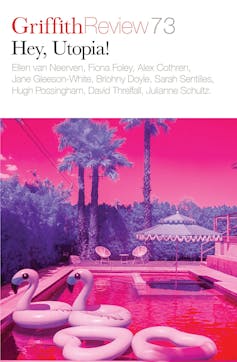 Just 14 months earlier Scott Morrison, then the Immigration Minister, had announced the formation of the new armed and uniformed force, describing it as the “reform dividend from stopping the boats”.
The 70 year-old department had gained a new role: “Border Protection”. The old tags — “Multiculturalism”, “Citizenship” and “Ethnic Affairs” — were artefacts of other ages when population growth coupled with social cohesion had been the goal. The armed Border Force that had emerged out of the chrysalis of the old customs service, complete with new uniforms, ranks and insignia, on that mid-winter day was another sign of Canberra’s increasing preoccupation with security and militarisation.
Fear and safety were still at the heart of the political narrative just as they had been for most of the time since 2001, when Prime Minister John Howard won an unlikely election victory by declaring over and over: “We will decide who comes to this country and the circumstances under which they come”.
He liked to reassure people that Australia would still be taking more than its share of refugees, but the proportion of overseas-born residents fell over the early years of his prime ministership. After decades of multiculturalism the Australian ear was once again being attuned to new arrivals as threat.
Just 14 months earlier Scott Morrison, then the Immigration Minister, had announced the formation of the new armed and uniformed force, describing it as the “reform dividend from stopping the boats”.
The 70 year-old department had gained a new role: “Border Protection”. The old tags — “Multiculturalism”, “Citizenship” and “Ethnic Affairs” — were artefacts of other ages when population growth coupled with social cohesion had been the goal. The armed Border Force that had emerged out of the chrysalis of the old customs service, complete with new uniforms, ranks and insignia, on that mid-winter day was another sign of Canberra’s increasing preoccupation with security and militarisation.
Fear and safety were still at the heart of the political narrative just as they had been for most of the time since 2001, when Prime Minister John Howard won an unlikely election victory by declaring over and over: “We will decide who comes to this country and the circumstances under which they come”.
He liked to reassure people that Australia would still be taking more than its share of refugees, but the proportion of overseas-born residents fell over the early years of his prime ministership. After decades of multiculturalism the Australian ear was once again being attuned to new arrivals as threat.
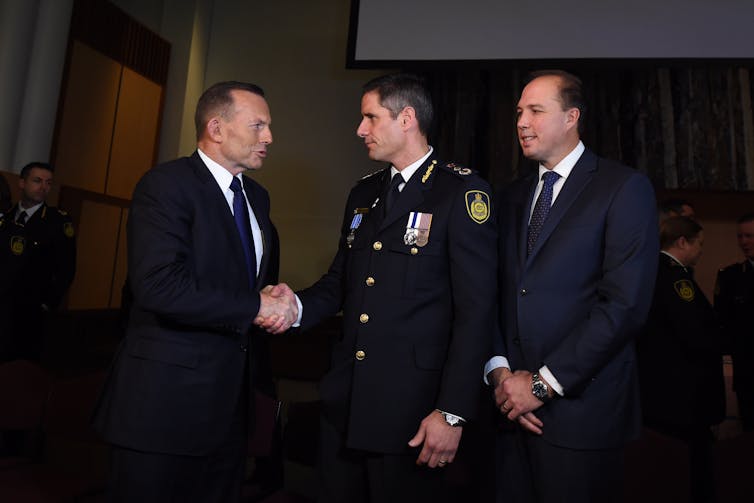 Then Prime Minister Tony Abbott (left) and Immigration Minister Peter Dutton congratulate the new Commissioner of the Australian Border Force Roman Quaedvlieg during the swearing-in ceremony at Parliament House in Canberra, Wednesday, July 1, 2015.
AAP Image/Lukas Coch
Read more:
Cruel, costly and ineffective: Australia's offshore processing asylum seeker policy turns 9
Taking it to the streets
By 2015, Australia’s proportion of overseas-born residents was nudging the all-time high of 30% reached in the 1890s, but multiculturalism was still a grubby word.
Without irony, Commissioner Quaedvlieg cut to the chase, reducing the new nearly 6,000-strong agency’s role to its essence: “to protect our utopia”. Decades before, the political philosopher Isaiah Berlin had elegantly demolished the idea of utopias, suggesting they were “a fiction deliberately constructed as satires intended to shame those who control existing regimes”.
A month after the launch of Border Force, its first big public exercise, Operation Fortitude, was announced. Officers were to walk the streets of Melbourne and seek proof of the right of residence of “any individual we cross paths with”. The warning was clear: If you commit border fraud you should know it’s only a matter of time before you are caught.
The residents of the Melbourne branch of “our utopia” fought back with a dose of theatricality, to prove Berlin’s point, and the joint operation with the Victorian Police was abandoned in a flurry of protests and press releases. Prime Minister Abbott declared, “Nothing happened here except the issue of a poorly worded press release”.
Within a couple of years, the uniformed commissioner from central casting had gone. The intent, however, remained clear. Immigration might be at an all-time high, but exclusion was still the key, and national security was at the centre of Australian public life.
Then Prime Minister Tony Abbott (left) and Immigration Minister Peter Dutton congratulate the new Commissioner of the Australian Border Force Roman Quaedvlieg during the swearing-in ceremony at Parliament House in Canberra, Wednesday, July 1, 2015.
AAP Image/Lukas Coch
Read more:
Cruel, costly and ineffective: Australia's offshore processing asylum seeker policy turns 9
Taking it to the streets
By 2015, Australia’s proportion of overseas-born residents was nudging the all-time high of 30% reached in the 1890s, but multiculturalism was still a grubby word.
Without irony, Commissioner Quaedvlieg cut to the chase, reducing the new nearly 6,000-strong agency’s role to its essence: “to protect our utopia”. Decades before, the political philosopher Isaiah Berlin had elegantly demolished the idea of utopias, suggesting they were “a fiction deliberately constructed as satires intended to shame those who control existing regimes”.
A month after the launch of Border Force, its first big public exercise, Operation Fortitude, was announced. Officers were to walk the streets of Melbourne and seek proof of the right of residence of “any individual we cross paths with”. The warning was clear: If you commit border fraud you should know it’s only a matter of time before you are caught.
The residents of the Melbourne branch of “our utopia” fought back with a dose of theatricality, to prove Berlin’s point, and the joint operation with the Victorian Police was abandoned in a flurry of protests and press releases. Prime Minister Abbott declared, “Nothing happened here except the issue of a poorly worded press release”.
Within a couple of years, the uniformed commissioner from central casting had gone. The intent, however, remained clear. Immigration might be at an all-time high, but exclusion was still the key, and national security was at the centre of Australian public life.
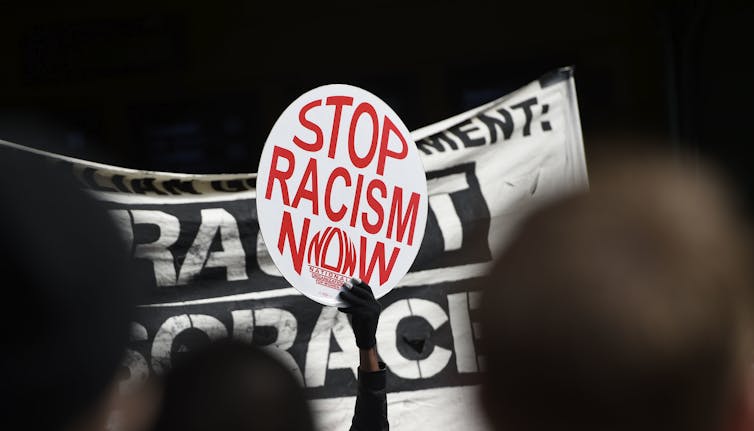 Protesters rally outside Flinders Street Station against the Australian Border Force’s Operation Fortitude plan to spot check visas in the streets of Melbourne, Friday, Aug. 28, 2015.
AAP Image/Mal Fairclough
Ills of the past and present
Deciding who could come and the circumstances under which they could enter the country has, as we have been again reminded during COVID times, been central to the management of the Australian utopia since 1901.
Again Isaiah Berlin notes the:
[…] idea of the perfect society is a very old dream, whether because of the ills of the present which lead men to conceive what their world would be like without them … or perhaps they are social fantasies – simple exercises in the poetical imagination.
Australia at the time of Federation was awash with bad poetry by mediocre poets. So if conceiving the nation as a utopia was an exercise of the poetical imagination, it was inevitably flawed.
Protesters rally outside Flinders Street Station against the Australian Border Force’s Operation Fortitude plan to spot check visas in the streets of Melbourne, Friday, Aug. 28, 2015.
AAP Image/Mal Fairclough
Ills of the past and present
Deciding who could come and the circumstances under which they could enter the country has, as we have been again reminded during COVID times, been central to the management of the Australian utopia since 1901.
Again Isaiah Berlin notes the:
[…] idea of the perfect society is a very old dream, whether because of the ills of the present which lead men to conceive what their world would be like without them … or perhaps they are social fantasies – simple exercises in the poetical imagination.
Australia at the time of Federation was awash with bad poetry by mediocre poets. So if conceiving the nation as a utopia was an exercise of the poetical imagination, it was inevitably flawed.
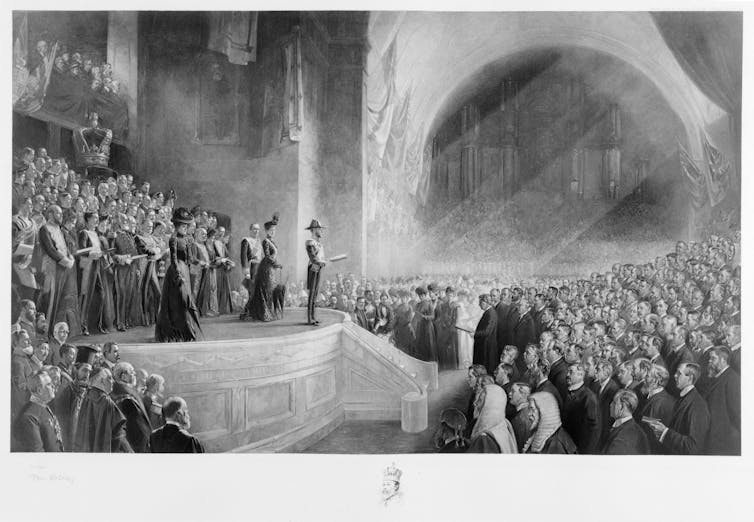 Tom Roberts’ depiction of the opening of the first Parliament of the Commonwealth of Australia May 9, 1901, By H.R.H. The Duke of Cornwall and York at Melbourne’s Exhibition Buildings.
State Library of Victoria/Tom Roberts
The first step towards the creation of Australia’s white utopia was brutal and relentless. It depended on the humiliation and elimination, by design and neglect, of the million First Nations people who in 1788 still called the continent home as they had done for countless generations, managed with an elaborate, ancient patchwork of languages, social relations, trade and lore.
Although the Australian Constitution explicitly excluded them from the census, by the time the 3.7 million new arrivals became Australians in 1901, the First Nations population had been reduced, systematically and deliberately, to about 90,000 people.
The men who debated the legislation that would shape the new nation preferred to avert their eyes. They were not, however, ignorant of what had gone before.
Even in a world shaped by race there was argument, opposition and some shame. Months after Australia became legally, unequivocally white, the parliament debated whether to recognise the survivors who preceded them.
The senate leader and future High Court justice Richard O’Connor argued that just as the right to vote was being extended to women — because in some states, they already had the franchise — the same principle should apply to Aboriginal people who had the right to vote in four of the former colonies. “It would be a monstrous thing, an unheard-of piece of savagery”, he declared, “to treat the Aboriginals whose land we were occupying to deprive them absolutely of any right to vote in their own country”.
Not everyone agreed. The former Tasmanian premier Edward Braddon summed up the majority sentiment:
We are told we have taken their country from them. But it seems a poor sort of justice to recompense those people for the loss of the country by giving them votes.
This argument prevailed. White women and Maori were the only exceptions: “no aboriginal native of Australia, Asia, Africa or the Islands of the Pacific” could enrol to vote. Within its first two years, the parliament had failed two moral tests.
At the heart of the Australia embraced by those who met in Melbourne in the Federation Parliament was the idea of a model society populated by men like them. Utopian dreams had played out in many ways in shaping the new nation. A decade earlier, nearly 300 colonialists sailed to Paraguay in a flawed attempt to create a more perfect, and even whiter, society called New Australia.
Tom Roberts’ depiction of the opening of the first Parliament of the Commonwealth of Australia May 9, 1901, By H.R.H. The Duke of Cornwall and York at Melbourne’s Exhibition Buildings.
State Library of Victoria/Tom Roberts
The first step towards the creation of Australia’s white utopia was brutal and relentless. It depended on the humiliation and elimination, by design and neglect, of the million First Nations people who in 1788 still called the continent home as they had done for countless generations, managed with an elaborate, ancient patchwork of languages, social relations, trade and lore.
Although the Australian Constitution explicitly excluded them from the census, by the time the 3.7 million new arrivals became Australians in 1901, the First Nations population had been reduced, systematically and deliberately, to about 90,000 people.
The men who debated the legislation that would shape the new nation preferred to avert their eyes. They were not, however, ignorant of what had gone before.
Even in a world shaped by race there was argument, opposition and some shame. Months after Australia became legally, unequivocally white, the parliament debated whether to recognise the survivors who preceded them.
The senate leader and future High Court justice Richard O’Connor argued that just as the right to vote was being extended to women — because in some states, they already had the franchise — the same principle should apply to Aboriginal people who had the right to vote in four of the former colonies. “It would be a monstrous thing, an unheard-of piece of savagery”, he declared, “to treat the Aboriginals whose land we were occupying to deprive them absolutely of any right to vote in their own country”.
Not everyone agreed. The former Tasmanian premier Edward Braddon summed up the majority sentiment:
We are told we have taken their country from them. But it seems a poor sort of justice to recompense those people for the loss of the country by giving them votes.
This argument prevailed. White women and Maori were the only exceptions: “no aboriginal native of Australia, Asia, Africa or the Islands of the Pacific” could enrol to vote. Within its first two years, the parliament had failed two moral tests.
At the heart of the Australia embraced by those who met in Melbourne in the Federation Parliament was the idea of a model society populated by men like them. Utopian dreams had played out in many ways in shaping the new nation. A decade earlier, nearly 300 colonialists sailed to Paraguay in a flawed attempt to create a more perfect, and even whiter, society called New Australia.
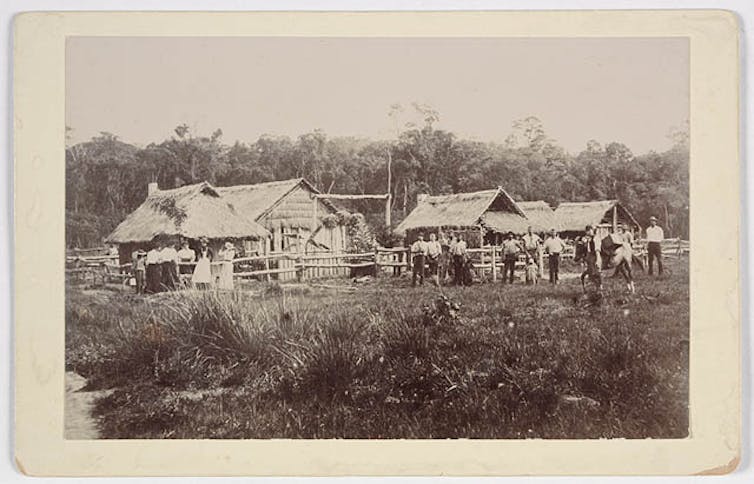 Looking for an even whiter utopia, several hundred people set off for Paraguay to establish the New Australia colony between 1892–1905.
Flickr/State Library of NSW
Prime Minister Edmund Barton, in the middle of the first year of the century, firmly grounded the new nation in the “instinct of self-preservation quickened by experience”. Optimism tempered by fear.
What became known as the White Australia policy was necessary, he said, because “we know that coloured and white labour cannot exist side by side; we are well aware that China can swamp us with a single year’s surplus population”.
Future prime minister Billy Hughes spelt out the two steps of this dance when he candidly observed that having “killed everybody else to get it”, the inauguration of Canberra — which they considered calling Utopia — as the national capital “was unfolding without the slightest trace of the race we have banished from the face of the earth […] we should not be too proud lest we should too in time disappear. We must take steps to safeguard the foothold we now have”.
Fresh eyes
In 1923 Myra Willard — a recent graduate of the University of Sydney — paid Melbourne University Press to publish its first monograph, her book History of the White Australia Policy to 1920. She wrote with a contemporaneous eye.
The debates in the colonies before Federation were still close enough for the lines between them and the 1901 legislation to be thickly etched with detail. She grimly recounted the way each colony penalised and excluded “coolies” and “celestials”.
“The desire to guard themselves effectively against the dangers of Asiatic immigration was one of the most powerful influences which drew the Colonies together,” she wrote. She quoted with approval the now infamous speech by Attorney-General Alfred Deakin in which he described the principle of white Australia as the “universal motive power” that had dissolved colonial opposition to Federation. At heart, he declared, was “the desire that we should be one people and remain one people without the admixture of other races”.
The Australian utopia depended on a “united race”. This would be ensured by “prohibiting the intermarriage and association that could degrade”. As Deakin declaimed in September that year, “inspired by the same ideas and an aspiration towards the same ideals of a people possessing a cast of character, tone of thought … unity of race is an absolute essential to the unity of Australia”.
The legislation was finally, if somewhat reluctantly, signed by Governor General Lord Hopetoun just before Christmas 1901. London was discomfited by the determination of the new nation to exclude and proposed amendments to save face with her imperial allies in Europe and Japan. Willard wrote in 1923, “Australia’s policy does not as yet seem to be generally understood or sanctioned by world opinion”. It was, she maintained, despite the negative connotations, really a positive policy that ensured Australia would be a productive global contributor of resources and supplies.
By the time the legislation passed, those with Chinese heritage were fewer than they had been in the 19th century. It did not take long before Indian residents who had lived in Fremantle for years, as British subjects, were denied the right to return to Australia after visiting their homeland. Those of German heritage, who made up about 5% of the population at the turn of the century, soon became pariahs — wartime internment was followed by the deportation of 6,000 Australians of German heritage.
Gough Whitlam revoked the policy as one of his first acts as prime minister.
“Right up to our election in 1972”, he recalled, “there had to be, from any country outside Europe, an application for entry referred to Canberra and a confidential report on their appearance […] The photograph wasn’t enough, because by a strong light or powdering you could reduce the colour of your exposed parts. It was said that the test was in extreme cases, ‘Drop your daks’ because you can’t change the colour of your bum’.”
For Michael Wesley, now deputy vice chancellor international at the University of Melbourne, and thousands of others, this meant that his Australian-born mother could return home with her Indian husband and brown babies without fear of deportation.
Read more:
German experience in Australia during WW1 damaged road to multiculturalism
The echoes still resonate. Fast forward to this year, when the average time in immigration detention rose to 627 days and the then Minister for Home Affairs, Peter Dutton, described deporting New Zealand-born long-term Australian residents who had been jailed as “taking the trash out”.
The suite of bills passed in that first parliament — at least as much as the Constitution — determined the social nature of Australia for much of the 20th century. As Deakin said a couple of years after the White Australia policy was adopted, “it goes down to the roots of our national existence, the roots from which the British social system has sprung”.
By the time he was prime minister, the bureaucratic method of exclusion was even clearer: “the object of the [language] test is not to allow persons to enter the Commonwealth, but to keep them out”. John Howard could not have asked for a better crib sheet than the speeches of the Federation Parliament when preparing his 2001 election campaign.
‘It’s about this nation saying to the world, we are a generous open-hearted people … but we will decide who comes to this country and the circumstances in which they come.’
Read more:
Australian politics explainer: the White Australia policy
Survival against the odds
That Australia has emerged as a cohesive multicultural society, with people drawn from hundreds of different countries — and increasingly from those that were once explicitly excluded — is a remarkable achievement. That the First Nations people have survived is in many ways even more remarkable.
But the foundation story of our notional utopia is still undigested and recurs unwittingly in policy language and political rhetoric, in legal and administrative practice and personal abuse.
The brutal speed and wilful political rejection of the Uluru Statement from the Heart would have shamed even the members of the Federation Parliament; the failure to turn enquiry into action on the oldest issue in the land — treaty, truth-telling and settlement with the descendants of those who have always been here — is unconscionable.
Methods of border control are now more likely to be couched in the convoluted small print attached to visas, employment conditions and bureaucratic processes, but at some level the old order prevails — there has been no national apology to those who were humiliated by the White Australia policy, no formal truth-telling to address these sins of the past at a national level. It has taken 23 years for the compensation recommended by Stolen Children inquiry to be parsimoniously granted.
Hands are thrown up in mock astonishment when another example of institutional or official racism, discrimination or maltreatment makes the headlines. Over a decade, the cost of detaining (and breaking) those refugees who felt compelled to leave their homeland reached double-digit billions. International criticism is once again worn with bravado as a badge of honour rather than a mark of shame. It was surprisingly easy to jettison 50 years of careful relationship-building with China.
Ever since those first debates in the Federation Parliament there has been a moral deficit in Australian politics, a reluctance to go back to first principles, to meaningfully make amends. Until this is addressed there will always be an action deficit. The big public health campaigns have not extended to addressing the lingering racism that has equally pernicious consequences.
No national political leaders rose to the defence of Adam Goodes when the 2014 Australian of the Year was called “an ape” and booed off the footy field. None came to the defence of Yassmin Abdel-Magied when she sought to contribute to public life. The response to the never-ending list of Aboriginal deaths in custody is couched in mealy-mouthed administrivia.
Looking for an even whiter utopia, several hundred people set off for Paraguay to establish the New Australia colony between 1892–1905.
Flickr/State Library of NSW
Prime Minister Edmund Barton, in the middle of the first year of the century, firmly grounded the new nation in the “instinct of self-preservation quickened by experience”. Optimism tempered by fear.
What became known as the White Australia policy was necessary, he said, because “we know that coloured and white labour cannot exist side by side; we are well aware that China can swamp us with a single year’s surplus population”.
Future prime minister Billy Hughes spelt out the two steps of this dance when he candidly observed that having “killed everybody else to get it”, the inauguration of Canberra — which they considered calling Utopia — as the national capital “was unfolding without the slightest trace of the race we have banished from the face of the earth […] we should not be too proud lest we should too in time disappear. We must take steps to safeguard the foothold we now have”.
Fresh eyes
In 1923 Myra Willard — a recent graduate of the University of Sydney — paid Melbourne University Press to publish its first monograph, her book History of the White Australia Policy to 1920. She wrote with a contemporaneous eye.
The debates in the colonies before Federation were still close enough for the lines between them and the 1901 legislation to be thickly etched with detail. She grimly recounted the way each colony penalised and excluded “coolies” and “celestials”.
“The desire to guard themselves effectively against the dangers of Asiatic immigration was one of the most powerful influences which drew the Colonies together,” she wrote. She quoted with approval the now infamous speech by Attorney-General Alfred Deakin in which he described the principle of white Australia as the “universal motive power” that had dissolved colonial opposition to Federation. At heart, he declared, was “the desire that we should be one people and remain one people without the admixture of other races”.
The Australian utopia depended on a “united race”. This would be ensured by “prohibiting the intermarriage and association that could degrade”. As Deakin declaimed in September that year, “inspired by the same ideas and an aspiration towards the same ideals of a people possessing a cast of character, tone of thought … unity of race is an absolute essential to the unity of Australia”.
The legislation was finally, if somewhat reluctantly, signed by Governor General Lord Hopetoun just before Christmas 1901. London was discomfited by the determination of the new nation to exclude and proposed amendments to save face with her imperial allies in Europe and Japan. Willard wrote in 1923, “Australia’s policy does not as yet seem to be generally understood or sanctioned by world opinion”. It was, she maintained, despite the negative connotations, really a positive policy that ensured Australia would be a productive global contributor of resources and supplies.
By the time the legislation passed, those with Chinese heritage were fewer than they had been in the 19th century. It did not take long before Indian residents who had lived in Fremantle for years, as British subjects, were denied the right to return to Australia after visiting their homeland. Those of German heritage, who made up about 5% of the population at the turn of the century, soon became pariahs — wartime internment was followed by the deportation of 6,000 Australians of German heritage.
Gough Whitlam revoked the policy as one of his first acts as prime minister.
“Right up to our election in 1972”, he recalled, “there had to be, from any country outside Europe, an application for entry referred to Canberra and a confidential report on their appearance […] The photograph wasn’t enough, because by a strong light or powdering you could reduce the colour of your exposed parts. It was said that the test was in extreme cases, ‘Drop your daks’ because you can’t change the colour of your bum’.”
For Michael Wesley, now deputy vice chancellor international at the University of Melbourne, and thousands of others, this meant that his Australian-born mother could return home with her Indian husband and brown babies without fear of deportation.
Read more:
German experience in Australia during WW1 damaged road to multiculturalism
The echoes still resonate. Fast forward to this year, when the average time in immigration detention rose to 627 days and the then Minister for Home Affairs, Peter Dutton, described deporting New Zealand-born long-term Australian residents who had been jailed as “taking the trash out”.
The suite of bills passed in that first parliament — at least as much as the Constitution — determined the social nature of Australia for much of the 20th century. As Deakin said a couple of years after the White Australia policy was adopted, “it goes down to the roots of our national existence, the roots from which the British social system has sprung”.
By the time he was prime minister, the bureaucratic method of exclusion was even clearer: “the object of the [language] test is not to allow persons to enter the Commonwealth, but to keep them out”. John Howard could not have asked for a better crib sheet than the speeches of the Federation Parliament when preparing his 2001 election campaign.
‘It’s about this nation saying to the world, we are a generous open-hearted people … but we will decide who comes to this country and the circumstances in which they come.’
Read more:
Australian politics explainer: the White Australia policy
Survival against the odds
That Australia has emerged as a cohesive multicultural society, with people drawn from hundreds of different countries — and increasingly from those that were once explicitly excluded — is a remarkable achievement. That the First Nations people have survived is in many ways even more remarkable.
But the foundation story of our notional utopia is still undigested and recurs unwittingly in policy language and political rhetoric, in legal and administrative practice and personal abuse.
The brutal speed and wilful political rejection of the Uluru Statement from the Heart would have shamed even the members of the Federation Parliament; the failure to turn enquiry into action on the oldest issue in the land — treaty, truth-telling and settlement with the descendants of those who have always been here — is unconscionable.
Methods of border control are now more likely to be couched in the convoluted small print attached to visas, employment conditions and bureaucratic processes, but at some level the old order prevails — there has been no national apology to those who were humiliated by the White Australia policy, no formal truth-telling to address these sins of the past at a national level. It has taken 23 years for the compensation recommended by Stolen Children inquiry to be parsimoniously granted.
Hands are thrown up in mock astonishment when another example of institutional or official racism, discrimination or maltreatment makes the headlines. Over a decade, the cost of detaining (and breaking) those refugees who felt compelled to leave their homeland reached double-digit billions. International criticism is once again worn with bravado as a badge of honour rather than a mark of shame. It was surprisingly easy to jettison 50 years of careful relationship-building with China.
Ever since those first debates in the Federation Parliament there has been a moral deficit in Australian politics, a reluctance to go back to first principles, to meaningfully make amends. Until this is addressed there will always be an action deficit. The big public health campaigns have not extended to addressing the lingering racism that has equally pernicious consequences.
No national political leaders rose to the defence of Adam Goodes when the 2014 Australian of the Year was called “an ape” and booed off the footy field. None came to the defence of Yassmin Abdel-Magied when she sought to contribute to public life. The response to the never-ending list of Aboriginal deaths in custody is couched in mealy-mouthed administrivia.
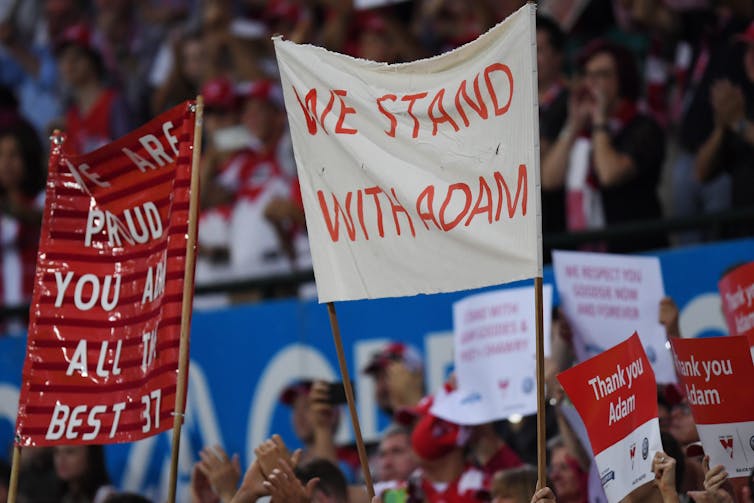 Public sentiment is at odds with that of those who are most committed to the old status quo.
AAP Image/Dean Lewins
When Prime Minister Julia Gillard was battered by misogynist hectoring, the message to other women was clear: don’t get ideas above your station. Almost every week a woman dies at the hands of her intimate partner, but overwhelmed police seem powerless to help.
Our treatment of refugees attracts a global condemnation that is dismissed as readily today as it was in 1901. Behrouz Boochani will probably never set foot in the country he described so searingly in his much awarded No Friend but the Mountains, and despite public support, the Murugappans — the Biloela family — spent nearly three years in costly detention on Christmas Island.
Yet when the government banned Australian citizens and permanent residents who happened to be in India as COVID raged from returning home under threat of fines and jail terms, the outcry was impossible to ignore.
The brutality of the old ways still lives in the memory. A colleague recalled her traumatic fear, during the family’s first trip to India with their Pakistani-born father, that the White Australia policy would be reintroduced and they would be denied re-entry. It had happened to those returning to Fremantle Harbour a century earlier — and, astonishingly, again in 2021.
Utopia out of step
Public sentiment is at odds with that of those who are most committed to the old status quo. Survey after survey shows a populace willing to embrace change that means people are treated better. But there are few leaders willing to make the case, fearful of an imagined backlash, rather than embracing the need for big tough conversation. Transformation is left to the slow accretion of a new normal.
Tens of thousands turned up at the football waving “I stand with Adam” banners years before the AFL officially apologised to Goodes.
Those affronted by official treatment of refugees engage in endless protest campaigns, travel to detention centres, provide support and lobby. The Black Lives Matter movement has galvanised some of the biggest demonstrations seen in the country, despite COVID, and the calls for action on the unfinished business of the 33-old Royal Commission into Aboriginal Deaths in Custody and the other inquiries are becoming impossible to ignore.
There is much to be learnt from First Nations people. Their survival and generosity is an inspiration that needs to be taken seriously and acted upon. Without righting this foundational wrong, this country will be forever stuck on a political treadmill, running but going nowhere.
Art speaks volumes
It is striking that one of the most important Aboriginal artists to have captivated the world came from a place called Utopia. Hers was the land of the Alyawarr people for millennia before its brief life as a cattle station. It is a place as impoverished as any of the remote settlements in northern Australia, returned to their traditional owners with only grudging support from the state. But the semi-arid country is the source of dreaming and a culture that speaks to the world when brought to life on canvas. Emily Kame Kngwarreye’s paintings are displayed in galleries, palaces and private collections around the world.
Public sentiment is at odds with that of those who are most committed to the old status quo.
AAP Image/Dean Lewins
When Prime Minister Julia Gillard was battered by misogynist hectoring, the message to other women was clear: don’t get ideas above your station. Almost every week a woman dies at the hands of her intimate partner, but overwhelmed police seem powerless to help.
Our treatment of refugees attracts a global condemnation that is dismissed as readily today as it was in 1901. Behrouz Boochani will probably never set foot in the country he described so searingly in his much awarded No Friend but the Mountains, and despite public support, the Murugappans — the Biloela family — spent nearly three years in costly detention on Christmas Island.
Yet when the government banned Australian citizens and permanent residents who happened to be in India as COVID raged from returning home under threat of fines and jail terms, the outcry was impossible to ignore.
The brutality of the old ways still lives in the memory. A colleague recalled her traumatic fear, during the family’s first trip to India with their Pakistani-born father, that the White Australia policy would be reintroduced and they would be denied re-entry. It had happened to those returning to Fremantle Harbour a century earlier — and, astonishingly, again in 2021.
Utopia out of step
Public sentiment is at odds with that of those who are most committed to the old status quo. Survey after survey shows a populace willing to embrace change that means people are treated better. But there are few leaders willing to make the case, fearful of an imagined backlash, rather than embracing the need for big tough conversation. Transformation is left to the slow accretion of a new normal.
Tens of thousands turned up at the football waving “I stand with Adam” banners years before the AFL officially apologised to Goodes.
Those affronted by official treatment of refugees engage in endless protest campaigns, travel to detention centres, provide support and lobby. The Black Lives Matter movement has galvanised some of the biggest demonstrations seen in the country, despite COVID, and the calls for action on the unfinished business of the 33-old Royal Commission into Aboriginal Deaths in Custody and the other inquiries are becoming impossible to ignore.
There is much to be learnt from First Nations people. Their survival and generosity is an inspiration that needs to be taken seriously and acted upon. Without righting this foundational wrong, this country will be forever stuck on a political treadmill, running but going nowhere.
Art speaks volumes
It is striking that one of the most important Aboriginal artists to have captivated the world came from a place called Utopia. Hers was the land of the Alyawarr people for millennia before its brief life as a cattle station. It is a place as impoverished as any of the remote settlements in northern Australia, returned to their traditional owners with only grudging support from the state. But the semi-arid country is the source of dreaming and a culture that speaks to the world when brought to life on canvas. Emily Kame Kngwarreye’s paintings are displayed in galleries, palaces and private collections around the world.
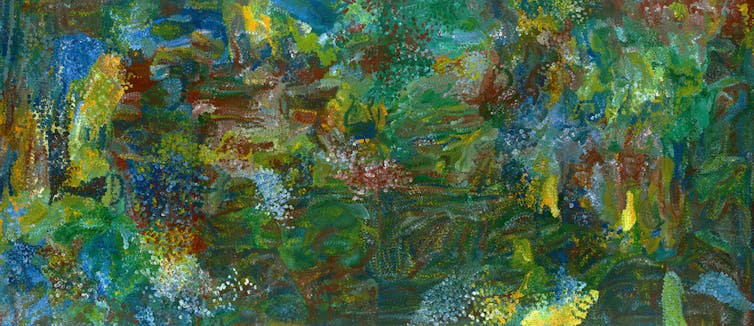 One of Australia’s most famous contemporary paintings, Earth’s Creation 1, by Emily Kame Kngwarreye.
AAP Image/Emily Kame Kngwarreye
They are more than great works of art. It is what Australian art always aspired to be. In the words of the influential Aboriginal scholar and advocate Marcia Langton, Emily’s paintings
[…] fulfil the primary historical function of Australian art by showing the settler Australian audience, caught ambiguously between old and new lands, a new way to belong in this place rather than another […]
Creating a utopia, or at least an aspiration to do better, requires more imagination and courage than our current system of professional politics permits.
It needs more art and better faith. Politics, like everything else, is now in thrall to corporate modes of organisation and communication.
The emphasis is on the mission (to get elected) and KPIs (to deliver on promises). The headline of every corporate plan is the “vision”. It is always the hardest thing to define. But without a vision, any plan is meaningless. Our utopia needs a new vision, one not tinged by shame. The old ones have failed the test of time.
This is an edited extract of Facing foundational wrongs — careful what you wish for, republished with permission from GriffithReview73: Hey Utopia!, edited by Ashley Hay.
One of Australia’s most famous contemporary paintings, Earth’s Creation 1, by Emily Kame Kngwarreye.
AAP Image/Emily Kame Kngwarreye
They are more than great works of art. It is what Australian art always aspired to be. In the words of the influential Aboriginal scholar and advocate Marcia Langton, Emily’s paintings
[…] fulfil the primary historical function of Australian art by showing the settler Australian audience, caught ambiguously between old and new lands, a new way to belong in this place rather than another […]
Creating a utopia, or at least an aspiration to do better, requires more imagination and courage than our current system of professional politics permits.
It needs more art and better faith. Politics, like everything else, is now in thrall to corporate modes of organisation and communication.
The emphasis is on the mission (to get elected) and KPIs (to deliver on promises). The headline of every corporate plan is the “vision”. It is always the hardest thing to define. But without a vision, any plan is meaningless. Our utopia needs a new vision, one not tinged by shame. The old ones have failed the test of time.
This is an edited extract of Facing foundational wrongs — careful what you wish for, republished with permission from GriffithReview73: Hey Utopia!, edited by Ashley Hay.
Authors: Julianne Schultz AM, FAHA, Professor of Media and Culture, Griffith University, Griffith University
Read more https://theconversation.com/friday-essay-our-utopia-careful-what-you-wish-for-165314





